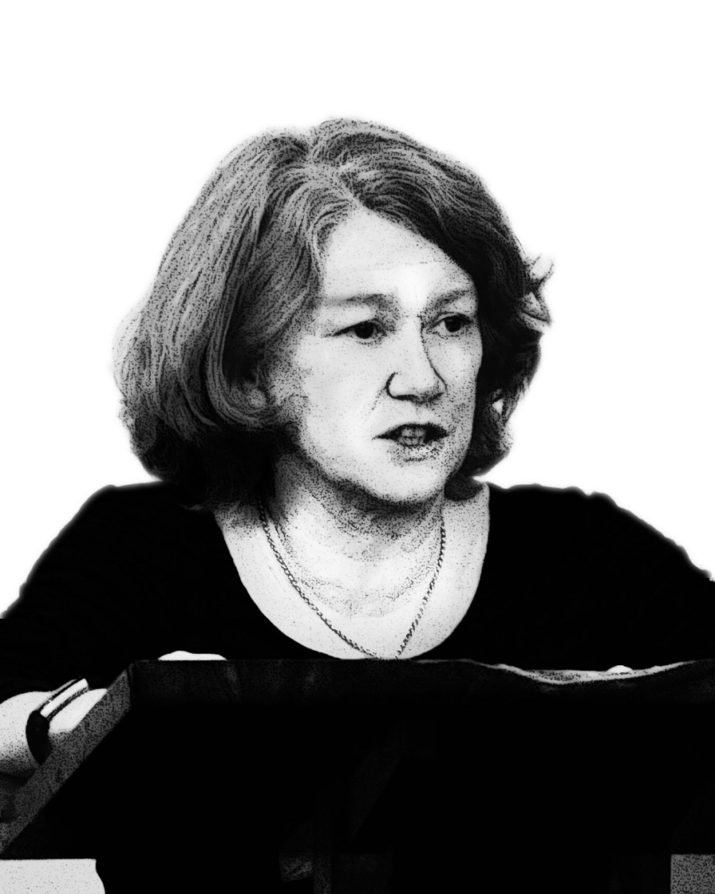
On Criminalized Identities and Empowering Marginalized Communities: An Interview with Geraldine Downey

This is part of our special feature, Diversity, Security, Mobility: Challenges for Eastern Europe.
I was delighted to interview Geraldine Downey Professor of Psychology and Director of Center for Justice at Columbia University. Earlier this spring, The Roma Peoples Project was approved by Columbia University, and since then has been housed by the Center for Justice. Professor Geraldine Downey, as well as her team, has offered key support for the development of the Roma Peoples Project at Columbia University by providing the project with an office, guidance, and other necessary resources.
–Cristiana Grigore for EuropeNow
EuropeNow What are the similarities between my project on Roma and the Irish Travellers?
Geraldine Downey The Irish Travellers and the Roma are among the most disadvantaged people in Ireland. The Travellers experience a low level of education, poor living conditions, and a lack of economic opportunities. Similarly the Roma who migrated to Ireland from different countries in Europe have experienced similar socio-economic challenges. As a psychologist, I am particularly concerned about the impact of these unfavorable conditions on their health and well-being. For instance, life expectancy is lower than the average for both Irish-Travellers and the Roma.
Also, both groups experience low-status identities. It is important to understand that, for example, begging, a recurrent media portrayal of Roma, is often not a choice but a surviving mechanism. Finding sustainable ways to develop positive identities will help develop a sense of worth and greater self-esteem for Irish Travellers and the Roma.
Recently in Ireland there has been a great effort to promote social inclusion for the Irish Travellers, but also the Roma. The Irish government just passed this year the National Traveller and Roma Inclusion Strategy for the years 2017–2021 and Irish Travelers have recently been recognized as an ethnic group. One organization I know, Pavee Point: The Traveller and Roma Center, supports both the travelers and the Roma.
So, I was very open and receptive to your idea of a project to bring together information about the Roma, but also to connect it with the Irish Travellers.
EuropeNow How about similarities between Roma scholarship and other fields of study in the academic world?
Geraldine Downey Roma scholarship and related topics are very much part of the area that I work in at Columbia, which is the scholarship around people who are marginalized. As a Professor of Psychology, I’ve spent years studying how experiences of rejection can shape our identities. Rejection is often personal, but can also be societal and cultural. In the United States, for example, we see a form of rejection in our history of racism and its manifestations in slavery and incarceration. And in Europe,, many people prefer to not have Roma as neighbors and they are on the lowest “like-ability” scale below other stigmatized groups.
I was also aware of the possible links with other work at Columbia especially around refugees, forced migration, and migrant groups. For example, what I have observed about Irish young people (not necessarily Travellers) who migrated to the United States and who are unsettled: getting into lifestyles that characterizes people who are disconnected from the bigger community such as excessive drinking, excessive partying, is perhaps the result of rootlessness and not being fixed in a community that has a purpose and that has a way forward.
I think that’s what you see not only in Irish migrants or settled Travelers in Ireland who were removed from their culture, but a lot of migrant groups where people are disconnected from tradition and not connected into the traditions of the larger society.
EuropeNow Why did you start the Center for Justice at Columbia University and what do you see as its main relevance in today’s sociopolitical climate?
Geraldine Downey The United States has the greatest incarceration rate, with more than 2 million people in its prisons and jails and it is, as many declare, the civil rights issue of today. The Center for Justice at Columbia University, launched in 2014, is dedicated to advance alternative approaches to safety and justice and to transform criminal justice from focusing on punishment and incarceration to being centered on prevention and healing.
I think the academia can play a significant role in enacting social change, positively impacting criminal justice policies and seeking effective ways for marginalized peoples to overcome stigma and criminalized identities.
EuropeNow Where do you see overlap between the criminal justice system in the United States and certain criminal justice systems in Europe, particularly as they affect Roma populations?
Geraldine Downey While the Center for Justice focuses on the crisis of mass incarceration in the U.S., we are also concerned about large-scale rejection of other stigmatized groups, such as the Roma, one of most excluded and discriminated group in the world, aware that in many European countries the Roma are incarcerated at disproportionally higher rate than non-Roma.
The Center for Justice’s and The Roma Peoples Project share a similar broad vision, to empower vulnerable communities who suffer from criminalized identities, discrimination, and exclusion from mainstream society. The Roma Peoples Project offers the Center for Justice an international perspective on criminalized identities.
EuropeNow What is a criminalized identity and how does it manifest?
Geraldine Downey Vulnerable children and other members of marginalized communities often share a sense of a feared identity, which is often the criminalized identity. The parents that I work with in prison are worried about how their conviction of a crime will affect their children and their relationship with them, since they are being portrayed as not good influences on their children; also their children are giving the sense that that’s who they may grow up to become. That’s a thrush of a criminal identity that’s used against the children.
The reason I teach college classes in prison is because student identity is a veryvalued identity in America and most societies. For people in prison and their families, their student identity, as well as the skills developed, is a counterweight, an alternative identification that magnifies in its benefits if somebody is incarcerated.
I think that in the case of Roma, not only particular individuals are seen as criminals, but also Roma identity in itself is criminalized. On of the meanings of “Gypsy” is synonymous with criminal, especially in Europe, where many people believe that criminality is in “gypsy blood.” Meanwhile, here in the States, people may use the word “gypsy” without knowing that Roma are an ethnic group that has suffered from scapegoating and that they are more at risk to be bullied and abused by others and also by authorities.
Because of my work with incarcerated people, I know that education can transform even the most marginalized of lives. Scholarship focusing on Roma history and identity and academia being inclusive to Roma scholars are vital steps in lifting the weight of centuries of stigma, and stereotypes. Just like in the case of incarcerated people in the United States, Roma need to develop a positive identity that has societal value, such as a student identity, that can overcome their stigmatized identities.
EuropeNow As a developmental psychologist who has worked substantially with “at-risk” youth, what risk factors do you see facing certain Roma children and young people today?
Geraldine Downey Currently, less than 1 percent of Roma are in higher education, and the implications of that for Roma can be substantial. Also, until this day, Roma children in Europe are still sent to segregated schools or even schools for children with special needs.
In addition to that, living in poor conditions at the margins of societies, can impact not only lacking opportunities and access to material goods, but also lacking stories of possibilities and achievement. Also, what lack of opportunity also means for Roma youth is lack of learning experiences and even failure as an opportunity to grow.
Often, for youth from minority groups, there is no room for error because the consequences for their mistakes are harsher and more immediate. This youth lack the ability to imagine themselves as someone better since they are expected to be beggars, thieves and drug dealers. They need space for trial and error, stories of possibilities so that their future could be as open as that of any other child or adolescent.
EuropeNow What are your thoughts on the Roma Peoples Project development so far?
Geraldine Downey I think that in the last six months or so, the project has evolved into something that’s real and the launch event it’s not just a dream anymore, the project is a real entity. The launch event showed how thinking about the Roma people could, in a global society, make us all think differently about global citizens or globalization. The Roma are potentially or possibly prototypical citizens of a global world since they have, in a sense, no fixed boat. I think that the question at the center of this is: What thinking about the Roma, a people with a long history of living in between cultural, can make us think about globalization today?
Geraldine Downey, Niven Professor of Humane Letters, is a former chair of the Psychology Department and currently directs the Center for Justice,which has as its mission using education, research and public engagement to help transform a criminal justice system from one that is driven by punishment and retribution to one that is centered on prevention and healing. Throughout her career, Professor Downey has sought to understand and reduce the impact of rejection and marginalization on people’s lives. Today much of her work focuses on reducing mass incarceration and supporting the success of people impacted by incarceration through education.
Cristiana Grigore is a research scholar and the founder of the Roma People’s Project at Columbia University, an initiative that spotlights Roma peoples and expands Roma studies. Upon arriving in the United States in 2006, Cristiana found a more conducive environment in which to express her previously concealed Roma identity. She is currently writing a book that explores how her immersion in American culture enabled her to grapple more fully with her Roma/Gypsy ethnicity. Her experiences have been featured by The New York Times, CNN, Al Jazeera America, PRI, and Voice of America, among other outlets. A Fulbright Scholar from Romania, Cristiana graduated from Vanderbilt University with an MA in International Education Policy and Management in December 2012. She earned her BA in Psychology from the University of Bucharest in 2007.
This part of our Campus Spotlight on Columbia University.
Published on December 6, 2017.




